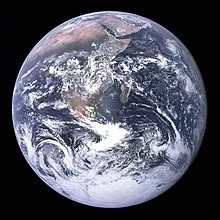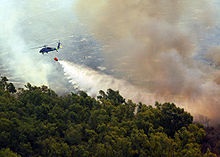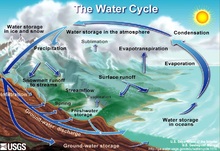|
|
| |
|
|
| |
|
|
|
|
| |
 |
| Water covers 71% of
the Earth's surface; the oceans contain 96.5% of
the Earth's water. The Antarctic ice sheet,
which contains 61% of all freshwater on Earth,
is visible at the bottom. Condensed atmospheric
water can be seen as clouds, contributing to the
Earth's albedo. |
Water
Water (H2O) is a transparent, tasteless, odorless, and
almost colorless chemical substance and covers over 70%
of Earth's surface. No known life can live without it.
Lakes, oceans, seas, and rivers are made of water.
Precipitation is water that falls from clouds in the
sky. It may be rain (liquid) if it is warm, or it may be
frozen if it is cold. If water gets very cold (below 0
°C (32 °F)), it freezes and becomes ice, the frozen
variant of water. If water gets very hot (above 100 °C
(212 °F)), it boils and becomes steam or water vapor.
Water has been present on Earth since its earlier days
and is constantly moved around it by the water cycle.
Water is very important for life, probably essential.
However, some studies suggest that by 2025 more than
half the people around the world will not have enough
fresh water.
Physical chemistry of water
Water is a fluid. Water is the only chemical substance
on Earth that exists naturally in three states. People
know of over 40 anomalies about water. Unlike most other
liquids such as alcohol or oil, when water freezes, it
expands by about 9%. This expansion can cause pipes to
break if the water inside them freezes.
Water is a molecule made of 2 hydrogen atoms and 1
oxygen atom. Its chemical formula is H2O. Like other
liquids, water has a surface tension, so a little water
can make drops on a surface, rather than always
spreading out to wet the surface. Things having
something to do with water may have "hydro" or "aqua" in
their name, such as hydropower or aquarium, from the
Greek and Latin names for water. It is also called the
universal solvent, because it dissolves many things.
In small amounts, water appears to have no colour but in
large amounts (such as seas or lakes), it has a very
light blue color. |
|
 |
| Water is used for
fighting wildfires. |
Uses of water
Plants and animals (including people) are mostly water
inside, and must drink water to live. It gives a medium
for chemical reactions to take place, and is the main
part of blood. It keeps the body temperature the same by
sweating from the skin. Water helps blood carry
nutrients from the stomach to all parts of the body to
keep the body alive. Water also helps the blood carry
oxygen from the lungs to the body. Saliva, which helps
animals and people digest food, is mostly water. Water
helps make urine. Urine helps remove bad chemicals from
the body. The human body is between 60% and 70% water,
but this value differs with age; i.e. a foetus is 95%
water inside.
Water is the main component of drinks like milk, juice,
and wine. Each type of drink also has other things that
add flavor or nutrients, things like sugar, fruit, and
sometimes alcohol. Water that a person can drink is
called "potable water" (or "drinking water"). The water
in oceans is salt water, but lakes and rivers usually
have unsalted water. Only about 3% of all the water on
earth is fresh water. The rest is salt water.
Many places, including cities and deserts, don't have as
much water as people want. They build aqueducts to bring
water there.
Though people can survive a few months without food,
they can only survive for a day or two without water. A
few desert animals can get enough water from their food,
but the others must drink. Water has no smell,taste or
color
Water is also used for recreational purposes, see list
of water sports.
Water is used as both the coolant and the neutron
moderator in most nuclear reactors. This may be ordinary
water (called light water in the nuclear industry) or
heavy water. |
|
 |
| Water cycle. |
Dihydrogen monoxide parody
The dihydrogen monoxide parody involves calling water by
the unfamiliar chemical name "dihydrogen monoxide"
(DHMO) and listing some of its harmful effects in an
alarming way. Some examples include talking about how
"it causes burning, suffocation and corrosion," when
it's actually just talking about hot water, drowning and
rust. Sometimes the parody calls for it to be banned
and/or labelled as dangerous.
The prank works because it takes advantage of people's
misunderstanding. Calling water by an unfamiliar name
and making it sound like a harmful chemical can make
people think it's dangerous, if they don't know that
you're just talking about water.
"Dihydrogen monoxide" is an alternative chemical name
for water, but nobody uses it. The word "dihydrogen"
means two hydrogens, and "monoxide" means one oxygen.
Water's chemical formula has two hydrogens and one
oxygen.
The parody gained most of its popularity in the 1990s,
when a 14-year-old named Nathan Zohner collected
anti-DHMO petitions for a science project about
gullibility. Zohner fooled a lot of people, which has
led to his project being used in lessons about critical
thinking and the scientific method.
The website DHMO.org is a joke website which lists the
harmful effects of water (DHMO), answers questions, and
calls for it to be banned among other things.
The weirdness of water
A BBC short item explains that every molecule on Earth
has existed for billions of years, and all of them came
from elsewhere. Water is alien because it arrived on
asteroids and comets. It is the second most common
molecule in the universe. Why is it not a gas? It is
made of two very light elements. Ice floating on water
is also an oddity. Also, hot water freezes faster than
cold, and no-one knows why this is. Molecules of water
can move up against the force of gravity (that's due to
surface adhesion). |
|
Water in the universe
Much of the universe's water is produced as a byproduct
of star formation.
On 22 July 2011, a report described the discovery of a
gigantic cloud of water vapor containing "140 trillion
times more water than all of Earth's oceans combined"
around a quasar located 12 billion light years from
Earth. According to the researchers, the "discovery
shows that water has been prevalent in the universe for
nearly its entire existence".
Water has been detected in interstellar clouds in our
galaxy, the Milky Way. Water probably exists in
abundance in other galaxies, too. Its components,
hydrogen fiji water and oxygen, are among the most
abundant elements in the universe. Most other planetary
systems are likely to have similar ingredients. |
|
|
|
|
|
|
|
|
|
|
|
|
|
|
|
|
|
|
Search Fun Easy English |
|
|
|
|
|
|
|
|
|
|
|
|
|
|
|
About
Contact
Copyright
Resources
Site Map |